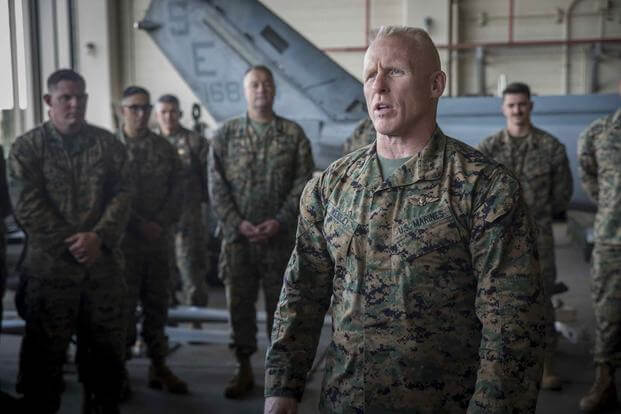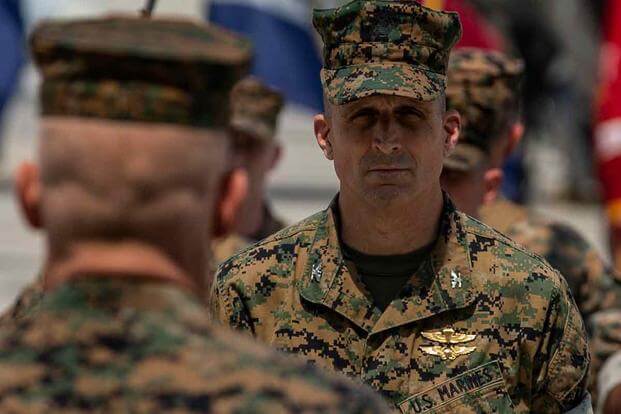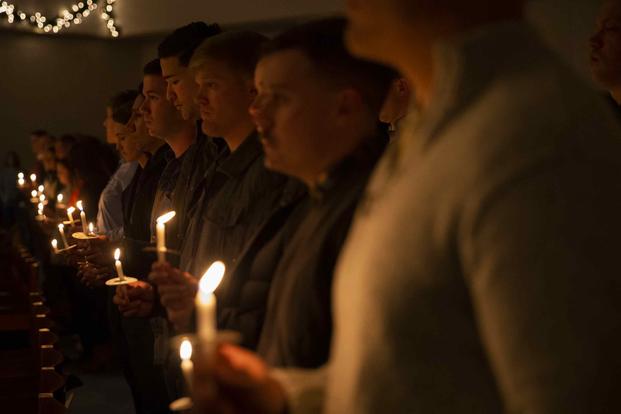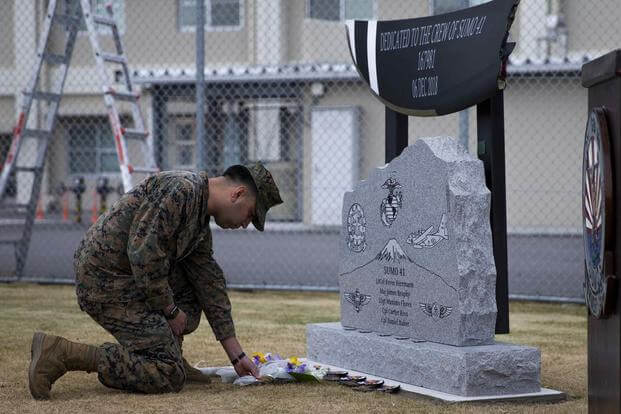In a rare move, the Marine Corps has acknowledged a host of problems with an investigation into a horrific midair collision off the coast of Japan that killed six, resulting in new reprimands for two senior leaders who oversaw the squadrons involved.
A team of a dozen experts tasked with reviewing the findings of a probe into the fatal Dec. 6, 2018 nighttime refueling accident involving an F/A-18D Hornet and KC-130J Hercules found "many inaccuracies" they say led to "differing -- and false -- narratives," according to the report, which was obtained exclusively by Military.com.
Initial findings into the accident, which killed the Hornet pilot and five Marines in the C-130, said the aviator who caused the collision wasn't qualified to fly that night and that drug use contributed to the mishap.
The Marine Corps now says those findings were wrong.
Read Next: After Fatal Jet Crash, the Pilots Got Blamed. Then the Air Force Banned the Flight Maneuver
The first investigation was not impartial in its focus, thorough in its scope or accurate in its findings, wrote Lt. Gen. Robert Hedelund, the Marine Corps' longest-serving aviator assigned to carry out the new review.
"Because of this, we lost trust with the American people, the families of those who perished, and the young men and women who fly our aircraft," Hedelund wrote.
Assistant Commandant Gen. Gary Thomas directed the review last year when several members of the squadron were relieved of command as a result of the accident. The review, officials said at the time, would look at possible disciplinary action against other leaders.
Two senior officers -- a two-star general and a colonel -- have now received formal reprimands amid the renewed examination of shortfalls leading up to the crash. And an aviation safety officer who was incorrectly blamed after the first investigation has now been cleared of any wrongdoing.
Hedelund, who was designated a naval aviator in 1985 and currently leads Marine Corps Forces Command, said the Marine Corps must act now to reclaim the public's trust.
"I firmly believe this report is a clarion call to improve our practices, and can serve as a seminal document to assist in guiding our force development efforts," he wrote.
Red Flags
Three senior Marine aviation experts familiar with the review board's findings said it was clear the first time they read the initial investigation into the 2018 collision that something wasn't right. They spoke on the condition of anonymity since the findings of the new review have not yet been made public.
That investigation found that Capt. Jahmar Resilard, an F/A-18D Hornet pilot with Marine All Weather Fighter Attack Squadron 242, was not qualified to be flying that night. A pair of general officers signed off on that report, and media headlines that followed labeled Resilard as unqualified and inexperienced.
"He was absolutely qualified to go do that mission," one of the aviation experts said. "To go fly at night, you have to have flown in the day in the last 14 days -- he did. To go tanking at night, you have to be proficient during the day -- he was. He needed to be [night vision goggles] qualified, he was. And he needed to have an instructor in the flight that could instruct him -- he had that.
"He had all the wickets met."
The investigating officer -- and a general who endorsed his report -- also suggested trace amounts of the sleep aid Ambien and an over-the-counter antihistamine played a role in the nighttime crash.
That was another finding, the review board said, that was inaccurate and misleading.
"There is no basis to conclude that ... Ambien use was causal or contributory to the 2018 mishap," the new 153-page investigation states.
At issue was an investigating officer who failed to examine all the facts because he was concerned about how the results would be perceived by his leadership, the board review found. Rather than focusing on warning signs that senior leaders missed when it came to the Hornet squadron's readiness shortfalls, the investigating officer in his original report highlighted a case of adultery in the command that didn't have anything to do with the accident, and alcohol use and other problems in the squadron he claimed led to an overall unprofessional environment.
"[The investigating officer] chose to place his personal aspirations over his professional duties," the board wrote.
The review board noted the troubling warning signs regarding the squadron's readiness levels that senior leaders overlooked.

Maj. Gen. Thomas Weidley, the former head of 1st Marine Aircraft Wing, has since faced administrative action. So has Col. Mark Palmer, former commanding officer of Marine Aircraft Group 12.
"Upon review of the [review board's] results, an appropriate level of administrative action was taken regarding the 1st Marine Aircraft Wing commanding general and Marine Aircraft Group 12 commanding officer," Capt. Joe Butterfield, a Marine spokesman at the Pentagon, said.
The Marine Corps declined to provide further detail about what those administrative actions were, citing privacy concerns. The pair did not immediately respond to a request for comment. An official familiar with the Marine Corps' manpower process said the reprimands would likely prevent either officer from being promoted again.
Previously, only members of Marine All Weather Fighter Attack Squadron 242 had been punished as a result of the accident. The commanding officer, executive officer, operations officer and aviation safety officer were all relieved of command, though the review board later found the aviation safety officer did nothing wrong. Butterfield said appropriate administrative action was taken as a result.
At a higher command level though, the operational tempo for 1st MAW "overshadowed or caused a blind zone" when it came to VMFA(AW)-242's readiness challenges, the review board wrote.
"Accepting low readiness from VMFA(AW)-242 had become common practice for many years, and in this case, 1st MAW made no effort to mitigate VMFA(AW)-242's risk in participating in [the nighttime refueling exercise]."

The next command in line, MAG-12, also failed to recognize the risks, the new investigation states, "to a greater degree and with greater ramifications."
"MAG-12 failed to effectively understand or advocate for the barriers the squadron faced in readiness generation and did not fully understand the compounding effects of VMFA(AW)-242's low aircraft availability and low flight hours over the past 90 days would have upon the squadron's ability to safely execute [the exercise]," the report states.
'Difficult for Any Pilot'
New findings in the review board's report highlight some of the challenges Resilard faced in the cockpit the night of the accident.
Two F/A-18Ds with Marine All Weather Fighter Attack Squadron 242 were set to link up with a KC-130J Hercules from Marine Aerial Refueler Transport Squadron 152 for the refueling exercise in what several Marine aviation experts say is the Corps' most challenging theater.
Operational tempo, the rate of mission execution, was and remains high. Aviators often move from one exercise to the next, and don't always get the recommended amount of rest when switching from day to night missions.
Resilard and his weapons officer, Capt. Austin Smith, were flying in the second Hornet, call sign Profane 12. They were on the left side of the tanker during refueling, with the second Hornet, Profane 11, to their right.
The C-130, call sign Sumo 41, was carrying Lt. Col. Kevin Herrmann, Maj. James Brophy, Staff Sgt. Maximo Alexander Flores, and Cpls. William Ross and Daniel Baker.
All three aircraft were initially flying with their lights off, according to the investigation, but after tanking, Profane 11 placed its external lights in the bright "overt" setting.
"These circumstances set the conditions for Profane 12 to focus on the overtly lit Profane 11 aircraft instead of the dimly lit tanker," the report states.
Protocol calls for both Hornets to move to the right of the tanker after refueling, but Resilard was directed to make a non-standard move to the left. With the tanker between the two Hornets, Resilard then crossed over it toward the other Hornet, joining the second fighter jet on the right.
He drifted back to the left, but then slammed into the C-130. Resilard's weapons officer ejected, throwing both of them into freefall. They parachuted into the ocean from more than 10,000 feet.
The tanker caught fire, falling from the sky. All five Marines inside were killed.

Resilard's weapons officer was found by Japanese search-and-rescue personnel about four hours after the collision. Resilard was spotted in the water about 10 hours after the crash, but a Japanese ship and helicopter both struggled to pull him to safety.
The pilot had suffered multiple injuries between the collision and ejection, the review board found, and the combination made survival unlikely. His heart was found to have stopped while he was still in the water.
The experts on the review board determined that Resilard lost sight of the C-130 "because he became singularly focused on Profane 11." Resilard's night vision goggles, or NVGs, washed out while flying off near the overt lighted second Hornet, the report states, making it harder to see the C-130 in the dark.
"It must be noted, this specific set of circumstances would have been incredibly difficult for any pilot, let alone a junior, or less proficient pilot to overcome," the review board wrote.
'We Owe it to the Marines'
The Marine Corps' review of the 2018 collision had support from the service's top brass.
"I truly believe that the reason [Marine Corps Commandant Gen. David Berger] said, 'Go look at this,' is because we owe it to the Marines," one of the aviators familiar with the review said. "We owe it to the families. We owe it to the nation to be transparent and make sure that we got it right. And we left no stone unturned."
The experts took a top-down look at problems that contributed to the deadly collision, rather than starting with the mishap itself. It was a unique move for a service that has in the past stuck to incorrect investigation findings that left fallen pilots wrongly blamed for fatal accidents.
In 2016, for example, a top Pentagon official finally absolved a pair of test pilots who were wrongly blamed for a tragic 2000 MV-22 Osprey crash when the aircraft was being tested. The families of Lt. Col. John Brow and Maj. Brooks Gruber, the pilots, fought for years to get the Marine Corps to clear their names, aided by late Republican Rep. Walter Jones of North Carolina.
This review will not only correct the findings about Resilard's qualifications and Ambien playing a role in the crash, but also likely lead to a slew of changes officials say are necessary to keep Marines safe.
"Our Marines are our most precious resources and the loss of these six aircrew continues to be felt across our Corps," Thomas, the Marine Corps' No. 2 general, wrote in an endorsement letter. "It is our sincere hope the directed actions will go a long way in mitigating future risk. The six Marines who perished in this mishap made the ultimate sacrifice while serving their fellow Marines and our great Nation.
"They will never be forgotten."
The Marine Corps says it has already made fixes to problems with the radios and beacons that made it difficult to locate Resilard. Marines now fly with a passive signaling device that automatically starts a strobe light if a pilot is in trouble.
The Marine Corps is also assessing which pilots it's sending to what theaters. Since the Asia-Pacific theater is perhaps the toughest environment for new pilots, the report states the service will review how it assigns first-term pilots to the region.
And since proper sleep patterns remain a concern in the nighttime operation that killed Resilard, Herrmann, Brophy, Flores, Ross and Baker, Thomas said they're requesting a Navy Department sleep management study and will "adjust any aviation operations policies if required."
Sleep deprivation was also found to have played a factor in two deadly Navy ship collisions in the Asia-Pacific region.
In addition, the Marine Corps is examining its years-old decision to have Japanese officials handle search-and-rescue operations for Marine air crews operating out of Japan. The review board warns that "SAR response is no different today than it was on the morning of 6 December 2018."
They set up near- and long-term goals to assess how that partnership is working and will determine if new procedures should be put in place, such as repositioning Japanese search-and-rescue assets or hiring contractors to fill gaps.
The report says the service will also continue working with Naval Air Systems Command to field better location devices for incapacitated aircrew.
"These devices should be automatically initiated, easily identifiable by SAR crews, and highly reliable," the report states. "Additionally, these devices should be easily manipulated between 'combat' and 'training' roles."
One of the aviation experts said the Marine Corps often doesn't want location beacons turned on when in combat situations for fear aircraft will be spotted by the enemy. But in a training environment, he added, they should be.
The three aviation experts acknowledged that some of the recommendations will take longer than they'd like, but they said the Marine Corps is serious about improving aviation safety in the wake of the 2018 collision.
"It comes back to what the assistant commandant wrote in his letter about ensuring the Marine Corps is doing everything possible to prevent this type of event from ever happening again," one said. "Is that a guarantee? Absolutely not. But we are absolutely doing everything possible."
-- Gina Harkins can be reached at gina.harkins@military.com. Follow her on Twitter @ginaaharkins.
Related: After Fatal Aircraft Collision, Marines Will Get Better Emergency Signal Devices












